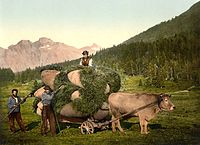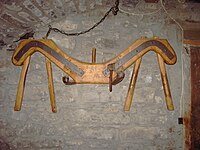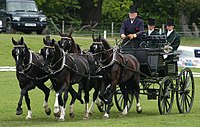Harness (draft animal)
The dishes or the Schirrung (Engl. Harness ) serves draft animals clamp so that they, for example, a (n) carts , plow , loop , carriage or wagon can draw well.
Common types of dishes
Depending on the animal and intended use, there are different names and types of harnesses today, which have been successively developed over a long period of time. Due to the higher costs for horses, their use was initially limited, early exceptions are, for example, in combination with the breastplate chariot .
In Central Europe today almost exclusively horses and thus the kumt and breastplate harness are used. The main materials used in Europe today are leather , nylon and other plastics , but in developing countries harnesses made of chains , wood , linen or tied straw are still often used .
yoke
The yoke is the oldest way of harnessing large draft animals . It appears around 3500 BC. In the Middle East and parts of Europe in illustrations and archaeological finds. Its use, however, is older and can be traced indirectly through plow marks and the castration of bulls. The older references are uncertain in terms of assignment or dating and only very few.
The original shape of the yoke is the head yoke with the two variants forehead and neck yoke. Both are attached to the horns of the draft animal, the forehead yoke in front of it, the neck yoke behind it. The head yoke is therefore only suitable for those who wear horns . The draft animals were mostly clamped in pairs in double yokes (old sketches from the Orient are not clear), whereby the load was pulled over a drawbar attached to the yoke between the animals . Due to this harness, the animals can hardly move their heads, which is an essential part of the proverbial "subjugation" of the animals. Oxen were mostly used as draft animals, which were easier to handle because of the castration. But cows, sometimes referred to as driving cows, were and still are harnessed to wagons.
The second form of the yoke is the withers yoke, which is pushed by the draft animals with the withers . The yoke beam is placed in front of the withers of the draft animals, around their bows a U-shaped arch of elastic wood is placed and guided upwards through holes in the yoke beam. There it is fixed by originally wooden yoke nails, which are inserted through one of several holes in the zygomatic arch, which allows adaptation to the size of the draft animal. The yoke beam was originally a simple round wood, later it was adapted to the neck shape of the draft animals. Later yokes used whatever materials were readily available, for example iron fittings or, today, truck tires cut into strips as yoke arches.
The withers yoke was also initially used as a double yoke. The drawbar is connected to the yoke in a very simple articulated manner with the yoke ring and the drawbar nail. Single yokes only made sense for the double harnesses required because of their pulling power through a more complex harness with pull cords on both sides of each draft animal. Because of this, they took hold very late. “Yoke” often means double yoke, the single yoke then has names such as “half yoke” or “yoke”.
Since the high Middle Ages , the yoke was replaced by the introduction of the kumt wherever there was sufficient capital and the performance of the team was a criterion, especially when several horses were used at the same time. The yoke is still used today because of the low manufacturing effort and cost.
Breastplate harness
A breastplate harness or sling harness is a light horse harness in which the horse only pulls with its chest. The breastplate is used today together with light wagons, preferably on flat terrain. The breastplate tension is called land tension or Jucker tension and is also known as Hungarian tension .
Structure and function: The train is pulled over the so-called breastplate , a piece of padded leather about eight to twelve centimeters wide that runs over the chest of the draft animal . The tension cords over which the carriage is pulled are buckled on both sides of the breastplate . The breastplate is carried by a strap running over the neck, the neck strap, on the top of which usually two metal rings, the so-called leash eyes , are attached, through which the leashes are passed.
The breastplate harness also includes a selett (for single breastplate harness) or a comb lid (for multiple breastplate harness), which lie on the back behind the neck strap (or neck belt ) and are held by a waist belt and usually also a tail strap with a tail . In the buggy Selett carries the Anzen the car . The breastplate harness is usually made of leather or synthetic fiber nylon .
Breastplate harness, standard of Ur , 2500 BC Chr.
Origin and use: The breastplate harness is only suitable to a limited extent for heavy pulling, i.e. heavy loads or hilly terrain, as it has a small contact area compared to the kumt harness and restricts the draft animal's movement and, above all, breathing under heavy loads. It used to be common in flat areas such as Hungary, while in hilly areas and in rural areas it was mainly kumt dishes. Today the breastplate harness has become the most widely used harness in the recreational area of driving due to its simplicity and the wide range of adjustment options .
Cum
The Kumt (often also Kummet or Kummt ) is a stiff, padded ring or consists of such ring segments. It is placed around the neck of the draft animal and makes it possible to distribute the tensile force sensibly on the chest, shoulders and withers by means of a design appropriate to the species . This is the only way that horses can fully utilize their pulling power. A closed kumt is used, the pulling force is applied through the chest and shoulders. A kumt distributes the load better than a breastplate, it is gentler on the horse. Heavy pull can only be done with Kumt. In cattle, the kumt is usually connected at the top by a hinge and open and lockable at the bottom, since it cannot be slipped over the head because of the horns. The pulling force is mainly applied through the withers and shoulders.
The kumt must be adapted to the stature and neck shape of each animal, otherwise pressure points can quickly arise. A breastplate is more versatile and can be buckled up more easily for other horses. The cumulus, however, has to fit exactly. It consists of:
- a pillow , a padded ring, usually made of leather and filled with straw .
- a Kumtbügel , the steel or wooden ring to which the drawbar or the Anzen can be attached. The ring can be opened with a strap.
- a tip with a protective cap so that no water or dust can penetrate the pillow.
- a circuit chain ( Einspänner ) or a long ring ( Pairs ) for fixing the Aufhalter .
Kumt dishes were already used around 500 BC. Invented in China. However, it did not reach Europe until around AD 1000. Although it represented an important advance in agriculture to be able to use the full pulling power of the stronger horses in front of the plow , and draft horses were clearly more profitable, they were very reluctant to establish themselves in agriculture against the draft ox. They did not want to raise the higher costs easily. It was only when the prices of agricultural products fell rapidly in the late medieval crisis around 1400 that the horse finally almost completely ousted cattle as a draft animal because of its higher profitability .
Rhenish-German draft horse with a pointed collar
Marathon cumulative
The marathon kumt (also: French kumt ) is especially common in tournament sports . It is a combination of kumt and breastplate in one piece. The marathon cumulus distributes the tensile load over a particularly large area on the horse's shoulder and bow. Thus the horse is not constricted in the shoulder and can achieve a better pulling performance. A marathon kumt does not have to be adjusted as carefully as a normal kumt, as it is adjustable and therefore fits different horses.
Other animal species
Special harnesses are used for tensioning the draft animals , the dromedary , the trample , the lama , the Asian elephant and the reindeer, which are primarily found outside of Central Europe . Dogs, especially sled dogs , are also harnessed with their appropriate harness .
In recent times, "normal" domestic dogs are also often equipped with harnesses instead of just a collar for daily exercise, since harnesses do not pose a risk of choking. There are also sized harnesses for other small pets (cats, ferrets and rabbits, even rats).
See also
- Ancient history of transportation
- equipage
- Dog harness as a guide for dogs
- Pulling harness for sled dogs
- Irish yoke finds
- Bridle
literature
- Klaus Drawer: Tension and harnessing of pets . DLG-Verlag, Frankfurt (Main) 1959 (92 pages).
- Astrid Masson: Handbook cattle tension. Practical guide on the behavior, training, harnessing and tensioning of draft cattle . Strong horses publishing house, Lemgo 2015, ISBN 978-3-9808675-5-9 .
- Christian-Henry Tavard: saddle and bridle. The harness in the past and present . DuMont, Cologne 1975 (French: L'habit du cheval. Selle et Bride . Paris / Friborg 1975.).
- Jürgen E. Walkowitz: Logistics in the Neolithic and Chalcolithic In: Varia neolithica IV, 2006, ISBN 3-937517-43-X
- Friedrich Anton Zürn: Dishware or harness theory . Leipzig 1897, urn : nbn: de: bvb: 12-bsb00073026-7 .














